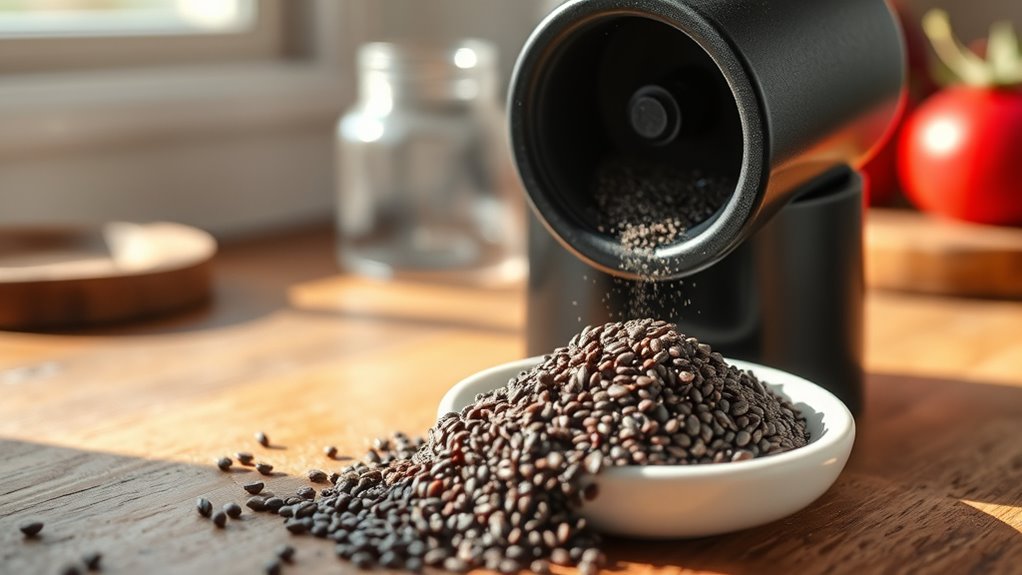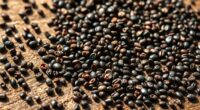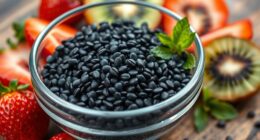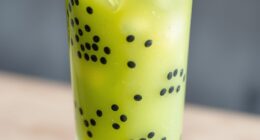To grind chia seeds, use a coffee grinder, spice grinder, or mortar and pestle to achieve your desired fineness. Grind small batches just before using them to maximize freshness and nutrient absorption, and store the ground seeds in an airtight container in a cool, dark place to prevent spoilage. Keep in mind, ground chia spoils faster than whole seeds, so proper storage is key. If you want to learn more tips, keep exploring how to get the most out of your chia seeds.
Key Takeaways
- Use a coffee grinder, spice grinder, or mortar and pestle to grind chia seeds to your desired fineness.
- Grind small batches just before use to maximize freshness and nutrient retention.
- Check expiration dates on pre-ground chia to ensure quality before grinding.
- Store ground chia in an airtight container in a cool, dark place to prevent spoilage and oxidation.
- Grind chia seeds when you need enhanced digestibility and nutrient absorption, typically just prior to adding to recipes or smoothies.

Grinding chia seeds is a simple process that can substantially boost their nutritional benefits and improve digestibility. When you grind chia seeds, you break down the tough outer shell, making it easier for your body to absorb the valuable nutrients inside. This includes omega-3 fatty acids, fiber, protein, and minerals like calcium and magnesium. Whole chia seeds are known for their long shelf life, but once ground, they can spoil faster due to their increased surface area. That’s why proper storage tips are essential to maintain freshness and prevent rancidity. To keep your ground chia seeds fresh, store them in an airtight container in a cool, dark place, such as the refrigerator or freezer. This helps preserve their nutritional benefits and prevents oxidation, which can diminish their healthful properties over time.
When considering whether you should grind your chia seeds, think about your diet and digestive health. Whole seeds are often safe for longer storage, but if you want to maximize nutrient absorption or improve digestion, grinding is the way to go. You might notice that ground chia seeds blend more seamlessly into smoothies, oatmeal, or baked goods, providing a smoother texture and more consistent nutrient intake. Also, because ground chia seeds are easier to digest, they’re especially beneficial if you have sensitive stomachs or are looking to boost your fiber intake without any added bulk. Additionally, grinding chia seeds can enhance their nutritional availability, making more nutrients accessible for your body to absorb.
The timing of grinding your chia seeds matters, too. If you buy pre-ground chia, check the packaging for freshness and expiration dates. However, if you prefer to grind your own, do it in small batches just before use. This way, you retain the maximum nutrition benefits and avoid the drawbacks of oxidation. Using a coffee grinder, spice grinder, or mortar and pestle allows you to control the fineness of the grind according to your preference. Remember, the finer the grind, the easier it is for your body to absorb the nutrients, but some people may prefer a slightly coarser texture for added crunch in recipes.
Frequently Asked Questions
Can I Grind Chia Seeds in a Blender or Food Processor?
You can definitely grind chia seeds in a blender or food processor. Blenders are efficient for small batches, quickly turning seeds into a fine powder. Food processors offer versatility, allowing you to grind larger quantities or coarser textures if needed. Just pulse in short bursts, and you’ll get the perfect grind. Whether you choose a blender or food processor depends on your preferred texture and the amount you’re preparing.
How Long Does Ground Chia Seed Last Before Going Bad?
Ground chia seeds typically last about 4 to 6 weeks when stored properly. To maximize flavor preservation and prevent spoilage, keep them in an airtight container in the refrigerator or a cool, dark place. Always use clean utensils to avoid introducing moisture or contaminants. Check for a rancid smell or off taste before use, and discard if you notice any signs of spoilage to guarantee freshness and safety.
Should I Soak Chia Seeds Before or After Grinding?
Imagine revealing chia’s full potential—should you soak before or after grinding? Soaking benefits your digestion, making nutrients easier to absorb, while grinding methods like using a coffee grinder or blender can quickly release their omega-3s. You can soak seeds first, then grind for a smoother texture, or grind first for convenience. Either way, both methods maximize chia’s health benefits, so choose what suits your routine best.
Is There a Difference in Nutritional Value Between Ground and Whole Chia Seeds?
You wonder if ground and whole chia seeds differ in nutritional value. Grinding improves bioavailability, making nutrients easier for your body to absorb. Whole seeds often retain more nutrients during storage, but grinding can slightly reduce nutrient retention over time. If you want maximum benefits, grind just before use. This way, you enjoy ideal nutrient absorption without sacrificing the nutritional quality of your chia seeds.
Can I Grind Chia Seeds in Advance for Weekly Use?
You can definitely grind chia seeds in advance for weekly use, but store them properly to maintain freshness. Use airtight containers to prevent moisture and flavor loss, and keep them in a cool, dark place. Grinding ahead saves time and enhances flavor when added to smoothies or oatmeal. Remember, properly stored ground chia seeds retain their nutrients longer, making your meals more nutritious and convenient throughout the week.
Conclusion
Grinding chia seeds release their full potential, making them easier to digest and more nutritious. When you grind them fresh, you’re unleashing a powerhouse of omega-3s, fiber, and antioxidants that can transform your health faster than a lightning strike. Just remember, if you want maximum benefits, don’t wait too long after grinding—these tiny seeds are like a ticking time bomb of goodness. So, get grinding and watch your wellness soar to new heights!









